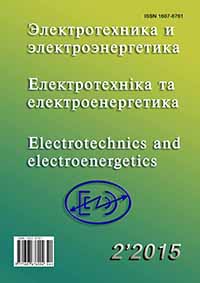CALCULATION OF THE OPTIMUM TACHOGRAM ACCELERATION AND DECELERATION OF FREQUENCY CONTROLLED ASYNCHRONOUS MOTORS
DOI:
https://doi.org/10.15588/1607-6761-2015-2-8Keywords:
asynchronous motor, frequency regulation, optimal tachogramsAbstract
Analytical calculations of private solutions of a linear second-order differential equation that describes the optimal trajectory of the change (tachograms) rate of variable-frequency induction motor (VFIM)are proposed. Under these tachograms the electromagnetic core loss minimization of engine power to start and stop the mode is ensured. This minimization is carried out for the specified start and end values †of speed and different acceleration and deceleration times. Calculations and comparison between optimal, suboptimal and famous (that are found in the current application in practice) energy saving tachograms sheets (linear and parabolic type, with the shape of a hyperbolic sine) are performed, as well as their respective basic electromagnetic losses of electricity, electromagnetic torque and modulus of the stator current VFIM. The calculated optimal and quasi optimal tachograms are designed for use in AC drives of rolling mills with VFIM working in the intensive start and stop modeReferences
Петров Ю. П. Оптимальное управление электроприводом. М–Л. : Госэнергоиздат, 1961. – 187с.
Петров Ю. П. Оптимальное управление электрическим приводом с учетом ограничений по нагреву. Л. : Энергия, 1971. – 144с.
Волков А. В., Колесников А.А. Энергосберегающее управление скоростью частотно-регулируемого асинхронного двигателя в пускотормозных режимах / Электротехника. – 2013. – № 5. – С. 2 –9.
Шрейнер Р. Т., Дмитренко Ю.А. Оптимальное частотное управление асинхронными электроприводами. – Кишинев: Штиинца, 1982. – 224с.
Корн Г., Корн Т. Справочник по математике для научных работников и инженеров. М. : Наука, 1984. – 832 с.
Downloads
How to Cite
Issue
Section
License
Copyright (c) 2017 V. A. Volkov

This work is licensed under a Creative Commons Attribution 4.0 International License.
Creative Commons Licensing Notifications in the Copyright Notices
Authors who publish with this journal agree to the following terms:
Authors retain copyright and grant the journal right of first publication with the work simultaneously licensed under aCreative Commons Attribution License that allows others to share the work with an acknowledgement of the work's authorship and initial publication in this journal.
Authors are able to enter into separate, additional contractual arrangements for the non-exclusive distribution of the journal's published version of the work (e.g., post it to an institutional repository or publish it in a book), with an acknowledgement of its initial publication in this journal.
Authors are permitted and encouraged to post their work online (e.g., in institutional repositories or on their website) prior to and during the submission process, as it can lead to productive exchanges, as well as earlier and greater citation of published work.

